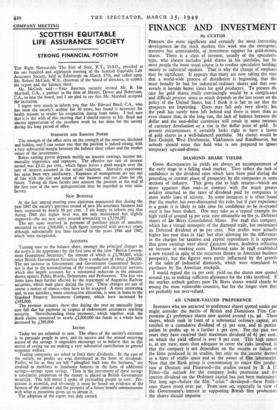FINANCE AND INVESTMENT
By CUSTOS
PERHAPS the most significant and certainly the most interesting development in- the stock markets this week was the emergence, tentative but unmistakable, of investment support for gold-mining shares. There is a class of investor, usually of the speculative type, who always includes gold shares in his portfolio, but for most people the more usual course is to confine speculative holdings mainly to industrial equities. That is why the change of emphasis may be significant. It appears that many are now taking the view that a world-wide process of disinflation is beginning, that this must broadly be bad for industrial ordinary shares and that con- versely it heralds better times for gold producers. To present the case for gold shares really convincingly would be a complicated and difficult process since so much depends in the last resort on the policy' of the United States, but I think it is fair to say that the prospects are improving. Cocts may fall only very slowly, but the peak has surely been left behind and there is more than an even chance that, in the long run, the lack of balance between the dollar and the non-dollar currencies will result in some measure of currency devaluation or a rise in the dollar price of gold. In present circumstances it certainly looks right to have a leaven of gold shares in a well-balanced portfolio. My choice would be East Geduld, West Driefontein, Vlakfontein and Randfontein, but nobody should enter this field who is not prepared to ignore temporary ups-and-downs.
DIAMOND SHARE YIELDS
Gross discrepancies in yields are always an accompaniment of the early stage in a falling stock market. They reflect the lack of confidence in the dividend rates which have been paid during the preceding or current phase of prosperity by the companies in some sections of industry. This gives rise to high returns—which are more apparent than real—in contrast with the much greater solidity attached to the rates of dividend paid by companies in more stable lines of activity. In some instances it is often found that the market has over-discounted the risks but if past experience is a guide it is likely to take time for confidence to be re-created once it has been shaken. One may take as a typical example the high yield of around 14 per cent. now obtainable on the 5s. Deferred shares of De Beers Consolidated Mines. For 1948 this company, which has a virtual monopoly of the diamond trade, has maintained its Deferred dividend at 90 per cent. Net profits were actually higher last year than in 1947 but after allowing for the differences in the charges for taxation and capital expenditure it is apparent that gross earnings were about L420,000 down, doubtless reflecting an increase in working costs. Diamond sales in 1948 established a new record in spite of the recurrent threats to American business prosperity, but the figures were partly influenced by the growth of the sales of industrial diamonds, which were stimulated by purchases by the American stockpile.
I would regard the 14 per cent. yield on the shares now quoted around 33s. as making sufficient allowance for the risks involved. If the market setback gathers pace De Beers shares would dearly be among the most vulnerable counters, but for the longer view they are probably not over-valued.
AN UNDER-VALUED PREFERENCE
Investors who are attracted to preference shares quoted under par might consider the merits of British and Dominions Film Cor- poration LI preference shares now quoted around 15s. 9d. These shares, which rank in front of a substantial ordinary capital, are entitled to a cumulative dividend of 54 per cent. and to partici- pation in profits up to a further I per cent. For the past two years they have received their maximum dividend of 64 per cent.. on which the yield offered is over 8 per cent. This high return is, in my view, more than adequate to cover the risks involved, in that the company is not dependent on the success or failure of the films produced in its studios, but only on the income derived as a hirer of studio space and as the owner of film laboratories. Now that the Rank group is concentrating its entire film produc- tion at Denham and Pinewood—the studios owned by B. & D. Films—the outlook for the company - looks promising and interim dividend on the Ordinary capital has just been maintained. Not long ago—before the film "crisis" developed—these Prefer- ence shares stood over par. From now on, especially in view of the Government's interest in supporting British film production, the shares should improve.'














































 Previous page
Previous page